
Breast Cancer Genomes — New Keys to Treatment
On the Road Again: Chu Travels the World To Tout Lab, Alternative Energy Projects
Breast Cancer Genomes — New Keys to Treatment
Work in Joe Gray’s laboratory has linked genomic aberrations in breast cancers to likely clinical outcomes, identified new genes involved in breast cancer, and specified new targets for drug therapy. Many of the key patterns found in tumor genomes are well modeled by breast cancer cell lines.
“Our goal is to understand how these abnormalities occur and how the genes associated with them function in breast cancer, so we can identify molecular differences among clinically similar tumors and design effective therapeutic agents against them,“ says Gray, who directs Berkeley Lab’s Life Sciences Division (LSD) and co-leads the Breast Oncology Program at the University of California at San Francisco’s Comprehensive Cancer Center.
Genome aberrations in tumors
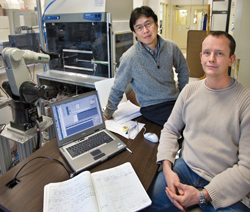
Koei Chin, left, and Richard Neve
photo by roy kaltschmidt, CSO
As normal cells develop into tumors, their genomes accumulate tell-tale changes. Gene amplification means multiple copies of a gene, which overexpress the protein it codes for; gene deletion causes reduced expression. When changes affect genes that regulate cell survival and cell proliferation, the result can be cancer.
Koei Chin, a guest in LSD and a member of the UCSF Comprehensive Cancer Center, and his colleagues have shown that analyzing a tumor’s genome copy numbers and gene expression can help predict how well a patient will respond to the aggressive treatments currently used to treat some breast tumors.
Moreover, says Chin, “In some types of breast cancer that don’t respond well to current treatments, our research pinpoints genes overexpressed by high amplification in specific regions of the tumor genome, which are potential targets for new or different drug therapies.“
Analysis of gene expression is a powerful method of typing breast cancers, says Chin, but while such assays can identify tens of thousands of genes, a sharper focus is needed for prediction. “By concentrating on combined analysis of genome copy number and expression, we have been able to identify a small number of genes that improve our ability to better predict clinical outcomes for some cancer subtypes.“
By mapping genome copy number abnormalities in tumors from 145 patients, and gene expression in 130 tumors, Chin’s team found specific regions of amplification and deletion that were associated with good and bad outcomes. In four of these regions they identified 66 genes that appear to play important functional roles in breast cancer.
Patients with tumors where these genome sites are amplified generally don’t do well, but the new analyses yield more accurate predictions, promising clinical assays that will allow patients and their physicians to make informed decisions about treatment options. And at least nine of the newly identified genes offer excellent “druggable“ targets for new therapies.
A cell-line system
Meanwhile, research by LSD’s Richard Neve and his collaborators has established that genome analyses based on a library of 51 breast-cancer cell lines maintained in vitro are substantially similar to Chin’s analyses of tumor tissues.
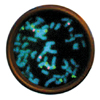
Under a microscope, excess copies of selected genes in the chromosomes of breast tumor cells are revealed by fluorescent markers.
Because the cell lines retain most of the recurrent patterns of genomic changes present in primary tumors, says Neve, “The genomic characteristics of the cell lines reflect those of the tumors -- not perfectly, but quite well, so we can use these to investigate how these characteristics influence the cancer biology.“
Oncogenes, genes associated with the development of cancer, are among those amplified in the genomes of cancerous cells, while tumor suppressors are among those deleted or suppressed. “We come out with a long list of potential oncogenes and tumor suppressors,“ says Neve, “a list that identifies many genes not previously thought to be associated with breast cancer.“
Not only does this information suggest novel drug targets, it can improve patient selection for clinical trials of new drugs. “We can pull out a gene profile and find the patients most likely to respond, which could save money and could also get much better results for those patients.“
Says Neve, “By using data from a growing library of cell lines, we can better understand how specific genomic or gene expression abnormalities influence cancer behavior. This can lead to a better treatment plan and a better understanding of possible outcomes, resulting in a better choice of therapeutic drugs.“
“Genomic and transcriptional aberrations linked to breast cancer pathologies,“ by Koei Chin and colleagues from UCSF, Berkeley Lab, the California Pacific Medical Center, and Affymetrix, Inc., appeared in the December, 2006 issue of Cancer Cell. Research was supported by the National Institutes of Health, the Department of Energy’s Office of Science, and the Avon Foundation.
“A breast cancer cell line ’system’ for functional cancer genomics,“ by Richard M. Neve and colleagues from Berkeley Lab, UCSF, the University of California at Berkeley, the Wayne State University School of Medicine, the University of Texas Southwestern Medical Center, the Georgetown University School of Medicine, and the University of Michigan Medical School, appeared in the same issue of Cancer Cell. Their work was supported by DOE’s Office of Science and the National Institutes of Health.
On the Road Again: Chu Travels the World To Tout Lab, Alternative Energy Projects
An evangelist on a mission, Steve Chu has traveled the world spreading the word about the urgent need for carbon-free fuel and the reasons why Berkeley Lab, in conjunction with UC Berkeley, is the place to develop it.
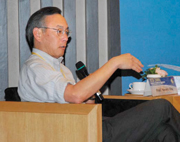
Director Chu shown speaking at the Trends in Chemical Dynamics conference in Taiwan in December.
In terms of sheer numbers, the Director has given 50 to 60 talks during the last calendar year on the challenge that global warming presents to the earth and its increasing demands for energy. And that doesn’t count the more informal briefings he has given to government and business leaders in California and Washington.
And he’s not slowing down in FY07. Take these current appearances as examples. Earlier this week, he gave a talk on energy alternatives and climate change for the “25x25” national committee at the California Department of Food and Agriculture in Sacramento (the group is seeking U.S. commitments to get 25 percent of its energy from renewable sources by the year 2025). He followed that on Wednesday morning with a presentation to the University of California Board of Regents on Helios, the Lab’s initiative to study solar-to-chemical energy conversions and alternative fuel systems.
Then across town to a day-long meeting with the Moore Foundation Board.
Yesterday, he participated in an international meeting on energy efficiency via conference call. Today, he is meeting with City of Berkeley community leaders to share with them the Helios project and the Lab’s Long Range Development Plan. Tomorrow he speaks at a Berkeley campus forum on “Energy Self-Sufficiency in the 21st Century.”
On Sunday, he flies to Southern California to deliver an invited talk at a two-day research conference on the energy problem. Then it’s off to Davos, Switzerland, to the internationally prestigious World Economic Forum, where his views on climate change and energy will be shared. At Davos, he will also moderate a panel on nuclear energy. Then it’s back to the U.S. for February appearances at the American Association for the Advancement of Science national meeting in San Francisco. His plenary lecture title: The Energy Problem and What We Can Do to Solve It.
That’s just a snapshot of the time and effort Chu is investing in raising the stakes for support of research into renewable energy science and climate change.
“It is important that I stay connected to the outside world,” Chu said. “It helps the Lab, and it helps the DOE.”
Case in point: his influence was cited among the main reasons why the Administration in Washington developed the FY07 budget request of $4.1 billion for the DOE Office of Science, a $505 million (14.1 percent) increase over FY06 funding. The support grew in part from the “Rising Above the Gathering Storm” report from the National Academy of Sciences, to which Chu was a major contributor. Although the funding for the new competitiveness initiative is stalled by this year’s Continuing Resolution in Congress, hope remains that bipartisan support will continue.
California Governor Schwarzenegger’s December announcement that up to $70 million of state money could be available for Helios and related energy projects sought by the Lab and campus underline Chu’s themes, which he has shared with the Governor and his staff for the past year. The UC Berkeley/LBNL partnership is one of only five invited by BP (formerly British Petroleum) to compete for a $500 million 10-year package of biomass research funding.
Chu, working through campus contacts, has already secured commitments of $15 million in private donations for the Helios effort.
The drumbeat is being heard everywhere, and it’s not over. In April, the InterAcademy Council, a consortium of 15 academies of science throughout the world, will release its long-awaited report, “Transitions to Sustainable Energy.” It is liable to have a lot of relevance for Berkeley Lab, since Steve Chu is the co-chair of the study committee.
“The idea is you start by knowing people,” Chu said of his ambassadorial strategy. “I wouldn’t have gotten Norm Augustine (distinguished former CEO of Lockheed-Martin) to be on our (Berkeley Lab) oversight board if we had not been on the ‘Gathering Storm’ panel together. You build relationships.”
And you spread the message. Chu even admitted that he’s not above a little “bait-and-switch” to get his point across. For example, in December he made several appearances in China and Taiwan, including a celebration of ex-Lab Nobelist Yuan T. Lee’s 70th birthday. Asked to give a scientific talk, he instead brought out his energy slides and convinced another audience of what he calls the planet’s biggest technological challenge. The slides, of course, included several about the distinguished 75-year legacy of Berkeley Lab.
“The Lab is seen as helping the world,” he said. “I am presenting the Lab as the extraordinary jewel that it is. It gives prominence to our own Lab and generates support for DOE and the national laboratory system.”
Berkeley Lab Authors
Confessions of a Girl Geek
Ask beamline scientist Corie Ralston how to get girls interested in science and she’ll give you an impassioned answer—the same plea she made in the essay she penned for She’s Such a Geek, a collection of writings by women who’ve ventured into the world of science and technology.
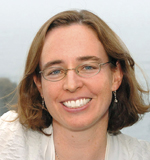
Corie Ralston
“The key is not to specifically encourage girls to go into science,” she writes in her essay, The Making of A Synchrotron Geek, “but to stop discouraging them from going into science.” Girls grow up knowing that they are more valued for their physical desirability than for their mathematical ability. Let girl geeks be who they are from day one, and don’t be afraid to celebrate their geekiness.
Ralston ought to know. As a born geek, gifted in math and science from a young age, and with a view of the world slightly different than other girls around her, she struggled to find her bearings in a world of science that was predominantly male. Along the way she faced her share of obstacles: the high school teacher who announced at the start of each school year that boys were better at physics than girls; the UC Berkeley math class where she earned the top grade, only to learn that the professor was surprised because he thought she “looked stupid.”
But Ralston persevered with encouragement from her parents, particularly her mother, a microbiology professor who shared her daughter’s love for science and commiserated over the trials of being a girl geek. And Ralston continued to fuel her appetite for math and science by reading, in the process falling in love with the science fiction of Heinlein, Asimov, and Bradbury.
Eventually, she found the literature of that era had some shortcomings: “The female characters in pre-‘70s science fiction exist only to serve the male characters… If you can imagine interstellar civilizations with galactic wormhole superhighways, why can’t you imagine female astronauts?”
Nevertheless, Ralston’s love of reading fueled another lifelong passion: writing. She is the author of a number of science fiction stories, and an Editor-at-Large for The Internet Review of Science Fiction.
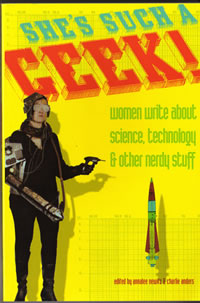
“Science fiction addresses the same fundamental issues as non-genre literature — what it means to be human, how we are connected (or not connected) to our families and our culture. But science fiction can look at these issues in a unique way because it isn’t limited to physical reality. For instance, in Ursula Le Guin's Left Hand of Darkness, she writes about a world in which people are neither male nor female, but become one or the other for a brief time every few weeks. In that context, she is able to examine gender roles in a way that would be impossible in mainstream literature.”
After earning a degree in Physics and Ph.D. in Biophysics, and doing post-doc work, Ralston decided to leave academia to join the Lab, managing beamlines 8.2.1 and 8.2.2 at the Advanced Light Source. She says this work allows her something a traditional academic career doesn’t: a personal life. One of the things that struck her while reading the essays in She's Such a Geek was the number of women who did not pursue a career at a university for the same reasons she didn’t: “The university environment can be very unforgiving of people who want to have an outside life.”
“Working at the Lab allows me to stay in touch with other scientists and feel I'm part of the scientific community even if I don't have my own research program,” she says. “I also get to do lots of fun stuff like engineering upgrades to the beamlines, teaching undergraduates, and helping other scientists in the lab.”
And of course, she gets to write.
Battle Between ‘Scammers’ and ‘Scambaiters’ Chronicled by Computer Engineer
Nearly everyone with an e-mail account has received one: A letter from a desperate person in Nigeria who lays claim to a large amount of money, but needs help with expenses in order to retrieve it. Over the years, thousands have fallen prey to this fraudulent plea.
But there are some who have decided to fight back against these “scammers.” They are called “scambaiters,” and they want to give scammers a taste of their own medicine.

Eve Edelson
Documenting the exchanges in this epic battle is Eve Edelson, a 21-year Lab veteran working in the Environmental Energy Technolo-gies Division as a computer systems engineer. She has collected a vast selection of scammer and scambaiter correspondence and provides commentary on these phenomena on a website called www.scamorama.com.
“Scambaiters create false identities and pretend to be interested in the Nigerian scams,” explains Edelson. “Tired of receiving these hoax letters, these pranksters are trying to exact revenge in a creative way.”
The website originated when Edelson posted warnings about the Nigerian scam, or “419” letters (the numbers refer to the Nigerian legal code assigned this crime). A few people who saw the site contacted Edelson saying they wrote letters back.
“One such person passed himself off as a doctor named Billy Rubin who heads a fake medical research institute,” says Edelson. “Others have used monikers such as Bart Simpson or Joe Stalin.”
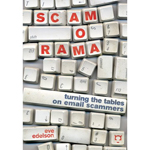
The scambaiter’s goal is to waste the scammer's time; engaging them in a continuous dialogue that will lead nowhere. Some baiters go so far as to provide fake documents, photos and fabricated flight itineraries to whet the scammer's appetites.
“I find this fascinating in a literary and historical way,” Edelson says. “This kind of scamming dates back at least to the 19th century and most likely before that.”
She came across a French letter from the year 1830 in which a person loyal to the recently deposed royals knew where treasure was hidden, but needed money to mount an expedition to unearth it. “It's nearly identical to the letters you see today,” says Edelson.
A publisher who visited Edelson's website was intrigued by her collection of scammer-scambaiter exchanges and offered her a book deal. The tome — Scamorama: Turning the Tables on E-Mail Scammers — is now available on Amazon.com and other venues.
Berkeley Lab View
Published once a month by the Communications Department for the employees and retirees of Berkeley Lab.
Reid Edwards, Public Affairs Department head
Ron Kolb, Communications Department head
EDITOR
Pamela Patterson, 486-4045, pjpatterson@lbl.gov
Associate editor
Lyn Hunter, 486-4698, lhunter@lbl.gov
STAFF WRITERS
Dan Krotz, 486-4019
Paul Preuss, 486-6249
Lynn Yarris, 486-5375
CONTRIBUTING WRITERS
Ucilia Wang, 495-2402
Allan Chen, 486-4210
David Gilbert, (925) 296-5643
DESIGN
Caitlin Youngquist, 486-4020
Creative Services Office
Berkeley Lab
Communications Department
MS 65, One Cyclotron Road, Berkeley CA 94720
(510) 486-5771
Fax: (510) 486-6641
Berkeley Lab is managed by the University of California for the U.S. Department of Energy.
Online Version
The full text and photographs of each edition of The View, as well as the Currents archive going back to 1994, are published online on the Berkeley Lab website under “Publications” in the A-Z Index. The site allows users to do searches of past articles.
Flea Market is now online at www.lbl.gov/fleamarket
Study Finds Urban Air is Rich With Bacteria
Urban air is teeming with more than 1,800 types of bacteria, according to a first-of-its-kind census of airborne microbes recently conducted by Berkeley Lab scientists. But don’t hold your breath – you’ve likely been breathing this microbial soup your entire life.
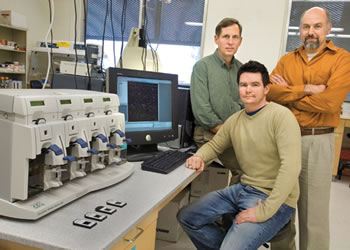
From left, Gary Andersen, Eoin Brodie, and Todd DeSantis next to a computer readout of the bacteria found in an air sample.
The team used an innovative DNA test to catalog the bacteria in air samples taken from the Texas cities of San Antonio and Austin. Surprisingly, they found a widely varied bacterial population that rivals the diversity found in soil. They also found naturally occurring relatives of microbes that could be used in bioterrorist attacks — although many of these relatives are harmless.
The research, published last month in the Proceedings of the National Academy of Sciences, serves two purposes. It paves the way for regional bacterial censuses that will help a bioterrorism surveillance program differentiate between normal and suspicious fluctuations in airborne pathogens. It will also help scientists establish a baseline of airborne microbes, which they can use to track how climate change affects bacterial populations.
To conduct the census, Andersen and colleagues used a test developed by Todd DeSantis, who is also with the Earth Sciences Division. Their DNA microarray, called PhyloChip, probes air samples for a gene involved in making proteins, called 16S rRNA, which is found in all bacteria. It can detect up to 9,000 different types of this gene, each unique to a different type of bacteria. The microarray is sensitive enough to differentiate among these thousands of gene sequences, meaning it can analyze an air sample and list every type of organism present.
Daily air samples were taken at several locations in San Antonio and Austin over a 17-week period, and then sent to Berkeley Lab. The team found 1,800 types of bacteria, including some pathogens, wafting in the air over the two cities. They also found that location was not as strong a source of microbial variation as time and weather.
“This information may help explain temporal spikes, which is important in bioterror surveillance,” adds Eoin Brodie, also with the Earth Sciences Division.
An airborne bacterial census will also enable scientists to track how climate change impacts the atmosphere’s microbial composition. This process is already occurring. Wind-blown dust and biomass from Africa’s expanding Sahara desert are reaching North America in significant quantities.
“We need to determine what’s in the air, so we can determine how climate change affects microbial diversity,” says Andersen.
Berkeley Lab, Campus Agree: It’s Better to Collaborate
When Berkeley Lab directors invite guests to speak at their annual strategic planning retreats with senior managers, they generally ask a VIP or two from academia or industry to offer perspectives on issues, programs or institutional dynamics. But what happened at Steve Chu’s second leadership meeting last fall was unprecedented.
Director Chu welcomed the UC Berkeley campus scientific brain trust – Chancellor Bob Birgineau, Vice Chancellor for Research Beth Burnside, and Faculty Deans Harrison Fraker (Environmental Design), the late Richard Newton (Engineering), Paul Ludden (Natural Resources), and Mark Richards (Physical Sciences). This was more than symbolic – the ensuing discussions at the two-day Santa Cruz conference launched a new era of collaboration and collegiality.
Physicist Birgineau set the tone on the first evening: “The UC Berkeley and Berkeley Lab combination is unequaled in the United States, maybe the world,” he told the audience of division directors and senior staff. “One of the most extraordinary aspects is the breadth and the depth that we have. The challenges of our times will be solved by, and require input from, a variety of areas, like science, engineering, public policy, and others. We have to learn new ways of working together. Our futures are tightly bound with each other.”
And so what followed were explorations of opportunity and potential conflict. History suggests that the two institutions, while inexorably tied together geographically and by employment (more than 200 Lab scientists share campus faculty appointments, and hundreds of UC Berkeley students work at the Lab each year), are separated by administrative, financial and even attitudinal differences. It was time, Chu and Birgineau told everyone, to tear down the barriers.
“These are exciting times for scientists,” Chu said. “We’ve been preparing for this for the last 75 years. We can marshal coherent teams. We together have incredible assets and intellectual resources. We need to be scrupulous opportunists to take full advantage of this environment.”
“The stimulation is there to meet and tackle long-standing irritations,” said Burnside, who with Lab Deputy Director Graham Fleming are co-leading a new collaboration initiative that has nine different campus-lab committees meeting now to identify mutual interests and issues – in finance, research, EH&S, space, infrastructure, information technologies, technology transfer, human resources, and public affairs.
“The better we partner, the stronger we are,” Chu said, adding that the most common detriments to a smooth relationship are moving money and moving people between campus and Lab. “There are confusing processes and mechanisms,” he said. “We need to define roles and responsibilities, clarify procedures with inherent differences, and adapt to the differing rate structures.”
Everyone in the room seemed to know what was at stake, and what exciting projects will benefit. Start with Helios and the young seedlings under its umbrella – the BP bioenergy research center, a $500 million prize for which campus and Lab jointly applied; and the Joint BioEnergy Institute (JBEI), another collaborative competition whose $125 million award from the DOE will be announced this year. Helios and other energy initiatives promise to make Berkeley and its two scientific giants the center of the world’s search for carbon-free fuels for future generations
Associate Laboratory Director Paul Alivisatos has 45 principal investigators from Lab and campus combining in a bid for $15 million in DOE solar cell research. And Mark Levine’s Environmental Energy Technologies Division is working with Fraker on a commercial buildings energy program, which aims to reduce building energy use by 80 percent by 2020. “We want the Lab and campus to push something like the Apollo project – we’ll get to zero-carbon buildings by 2030,” Fraker predicted.
The Lab’s late Earth Sciences Division Director, Bo Bodvarsson, will leave as part of his legacy the stimulation for a climate change science program with the campus, including what he termed at the meetings “the best carbon sequestration (research) program in the world” at Berkeley Lab.
Other areas of potential collaboration include nuclear engineering (a special interest of campus Dean Newton, who died unexpectedly on Jan. 2), the Joint Genome Institute (UC Berkeley already has over 25 projects at JGI), and computing (including the proposed petascale computing center to be awarded by the National Science Foundation later this year). Leaders in operations, especially EH&S and Finance, will be looking for ways to achieve economies of scale as well as more compatible inter-institutional rules through partnering.
“These are huge opportunities,”meeting host Chu concluded. “Both sides need to push this.”
A Farewell to ARMs: NCEM Closes Famed Microscope
To Make Way for New High-Tech Instrument
When one door closes, another door opens, Alexander Graham Bell optimistically opined, and this is certainly the case at the National Center for Electron Microscopy (NCEM), where the closing of one instrument that for more than a decade reigned as the world’s best microscope makes way for another that will one day wear the same crown.
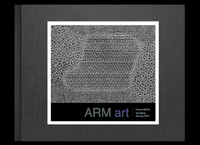
As a keepsake and tribute to the ARM era, NCEM researchers put together a coffee table book, Scientific Images at ARM, which featured a gallery of atom images, such as this micrograph, taken in 1996, of an alloy developed by General Motors.
An international gathering came to Berkeley Lab on Jan. 5, to celebrate the glorious past of the Atomic Resolution Microscope (ARM), which was decommissioned, and to plan what is expected to be an even more glorious future for the Transmission Electron Aberration-corrected Microscope (TEAM) that will take its place.
“The ARM brought atomic resolution to the materials sciences; it was the first instrument that made it possible to routinely see atoms,” said Uli Dahmen, who has directed NCEM since 1991. “It was the best of its time and this tradition will be continued. When TEAM 1.0 opens, it will be the best electron microscope on the planet.”
Dahmen preferred to view the ceremonies surrounding ARM as a “transitioning” rather than a “decommissioning,” because the new TEAM instrument will be housed in the same silo that housed the ARM, and will use the same deep foundation.
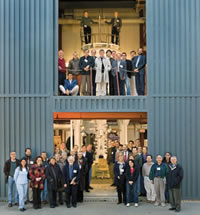
An international gathering of scientists came to Berkeley earlier this month to bid farewell to the Atomic Resolution Microscope (ARM) and firm up plans for its successor, the Transmission Electron Aberration-corrected Microscope (TEAM).
“Just as a new redwood grows up from the roots of an old redwood tree, so will the TEAM 1.0 rise up from the same pneumatic suspension base that once supported ARM,” Dahmen said.
In keeping with the spirit of analogies, it can also be said that as the successor to ARM, TEAM 1.0 has mighty big shoes to fill. When it opened in 1983 at the official dedication of NCEM, ARM and the High Voltage Electron Microscope (HVEM), which had been in operation since 1981, provided an unprecedented one-two technological punch in electron microscopy. Powered by a particle accelerator mounted atop its lens tube that could generate electron beams at energies up to one million electron volts, ARM became the first microscope to break the "two-angstrom" barrier, zooming in on a resolution of nearly 1.6 angstroms. This resulted in the first images ever of individual atoms in a sample.
"You won't find the images available here duplicated elsewhere in the country," declared NCEM’s founding father Gareth Thomas, when ARM opened for business. Thousands of scientific users agreed. For over the next two decades they flocked to Berkeley from across the nation and around the globe to get an “ARM’s eye view” of their samples. The images of black and white dots against gray backgrounds not only provided valuable clues that helped unlock the secrets behind material properties, they also beguiled the aesthetically minded with their artistry. In fact, Dahmen and his NCEM colleagues have published a coffee-table book of dazzling ARM images that’s as handsome as any art book you’re likely to find.
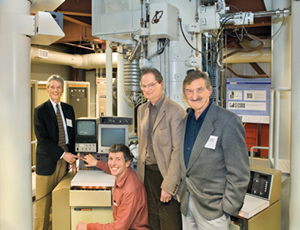
Uli Dahmen (far left), director of NCEM, along with Crispin Hetherington, a former ARM staff scientist now at Oxford University, Paul Alivisatos, director of the Materials Sciences Division, and Ken Westmacott, former NCEM director now retired, presided over the final shutdown of the ARM on Jan. 5.
“ARM became the DOE benchmark for how an instrument at a national user facility like NCEM can serve a large and diverse community of users,” said Dahmen. “The closing of the ARM marks the end of an era in electron microscopy, but when TEAM opens, we will see the start of a new era.”
The TEAM era will actually open in two stages and as two separate microscopes. First up, and occupying the silo that formerly housed the HVEM, will be TEAM 0.5, which is expected to be installed this summer. TEAM 1.0 will be constructed in 2008 and begin operating as a user facility in 2009. Both TEAM microscopes are designed as nanocharacterization instruments, able to resolve images to 0.5 angstroms in real-time. NCEM’s current best, the One Angstrom Microscope, can get down to about 0.8 angstroms, after several hours of computerized reconstructions. Real-time sub-angstrom resolutions in the TEAM microscopes will be made possible by aberration-correcting technologies in the electric and magnetic fields that constitute electron optics.
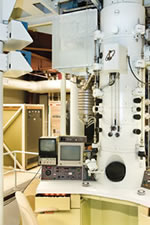
Opened in 1983, the Atomic Resolution Microscope provided a top resolution of 1.6-angstroms, which for many years was the best of any transmission electron microscope in the world.
“What we have done with software in the past, TEAM will do even better in the future with hardware,” said Dahmen. “TEAM’s aberration-correcting optics will enable us to achieve atomic resolution not only in real-time but also in 3-D.”
TEAM 0.5 will provide optical corrections for spherical aberrations (blurring) whereas TEAM 1.0 will correct for spherical and chromatic (rainbow distortions) aberrations. Until now, such aberrations have been the prime limiting factors in electron microscopy resolution.
TEAM is being designed and constructed through a collaboration led by Berkeley Lab that includes Argonne, Brookhaven and Oak Ridge National Laboratories, plus the University of Illinois. FEI Corporation of Hillsboro, Oregon, and the electron optics manufacturer CEOS, of Heidelberg, Germany, are the major commercial partners.
There are no second acts in America, F. Scott Fitzgerald once pessimistically opined, but the TEAM collaboration and the researchers at NCEM intend to prove that statement wrong.
Berkeley Lab: Plans for the Next 20 Years
What will Berkeley Lab look like in 2025? The next best thing to a crystal ball will be available on this coming Monday, when the Lab unveils a comprehensive planning blueprint for the next two decades.
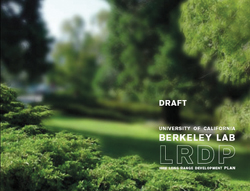
This important document, called the 2006 Long Range Development Plan (LRDP), establishes a framework of land-use principles to guide the Lab’s growth and other physical development through 2025. All University of California campuses, and Berkeley Lab, are required to maintain and periodically update their LRDPs. As part of this process, the Lab began drafting the LRDP in 2003. It is expected to be submitted to the UC Regents for approval in the fall of this year.
There’s a common theme throughout the LRDP’s 87 pages of maps, graphs, and projections: Science drives the Lab’s development, as does a need to preserve the Lab’s rustic hillside site. In this vein, the LRDP balances the Lab’s scientific goals with environmental stewardship and the flexibility to accommodate future research needs.
“As national challenges emerge, we must maximize the use of our scientific resources, revitalize our existing infrastructure, and make long-term investments in new scientific facilities,” said Director Steve Chu in the LRDP’s foreword. He adds that “as a leading institution in the areas of energy and environmental research, we are committed to developing the Laboratory in a manner that sets the standard for resource conservation and stewardship.”
With this in mind, the LRDP sets the stage for a safe, sustainable, cost-effective, and operationally flexible infrastructure capable of long-term support of evolving scientific missions. For example, the Lab’s Helios program, which seeks to develop abundant, carbon-neutral, and inexpensive solar-based energy technologies, will require modern research facilities. Unfortunately, 62 percent of the Lab’s buildings are over 40 years old, many of which do not meet the Lab’s anticipated research needs. Change is needed.
“The Laboratory will fall far short of its responsibilities to the nation if the facilities of previous generations are relied upon for a new generation of science,” said Chu.
Specifically, the demolition of older buildings and construction of new buildings will enable the Lab to conduct 21st century science and fulfill its mission as a multidisciplinary research institution. The same goes for increases in population and parking.
Importantly, this projected growth has not been mapped out in a vacuum. Based on assessments of what DOE and others will likely fund, and concerns from the community, the LRDP’s growth projections were reduced from their original 2003 estimates. Here’s the 2006 LRDP by the numbers:
• Population: Over the next 20 years, the Lab’s adjusted daily population of 4,375 (as measured in 2003) is projected to increase to 5,375. This is an average annual growth rate of 1.1 percent, or approximately 50 people per year, through 2025.
• Occupied building space: The Lab’s 2003 baseline of 1,760,000 gross square feet (gsf) of occupied building space is projected to increase to 2,420,000 gsf. This is a 1.8 percent per year increase over the next 20 years. The Lab proposes to demolish 320,000 gsf of occupied building space that is unsafe or beyond its useful life, and may build an additional 980,000 gsf, for a net increase of 660,000 gsf.
• Parking: The 2006 LRDP provides for up to 500 net new parking spaces over the next 20 years, an average annual increase of 1.1 percent. The Lab will review its transportation program when 375 additional parking spaces have been provided, or at 10 years, whichever comes first.
All of this requires environmental analyses, pursuant to the California Environmental Quality Act. A draft Environmental Impact Report (EIR), providing an assessment of the proposed project and its potential effects on the environment, will accompany the LRDP.

The LRDP also advances several design concepts that will shape the Lab’s infrastructure. Among them, the Lab will create a campus-like research environment. Seven already developed building clusters would increase in density to accommodate a projected increase in building space. This clustering of buildings — and people — is designed to enhance collaborative scientific inquiry.
The Lab will also promote alternatives to the use of single-occupant vehicles. A transportation demand management program will include commute alternatives, coordinated truck deliveries, and monitoring and studies of transportation improvements.
Environmentally friendly design is a key value promoted throughout the LRDP. Berkeley Lab will maintain its visual character marked by buildings among trees and shrubs along a vegetated hillside. The Lab will follow U.S. Green Building Council Leadership in Energy and Environmental Design (LEED) criteria on every new building, and new buildings will incorporate the Lab’s building energy efficiency research.
After the LRDP and accompanying EIR are issued on Jan. 22, the EIR will undergo a public review process that ends March 23. A public hearing for the EIR will be held at the North Berkeley Senior Center on Feb. 26. The LRDP and EIR are expected to be submitted to the UC Regents for review in the fall. If approved, they will replace Berkeley Lab’s existing LRDP and EIR, which were initially approved in 1987 (the EIR was updated in 1992 and 1997). The documents can be accessed at the Lab’s LRDP website: http://www.lbl.gov/LRDP/.
Ultimately, the 2006 LRDP will enable Berkeley Lab to tackle some of the most pressing scientific problems facing the planet while being a good neighbor to the surrounding region, and the nation.
“Let’s not take our current strength for granted,” said Chu in the foreword. “Let’s renew our commitment to research, education, and innovation while serving as a positive force in economic, environmental, and community responsibility.”
Berkeley Lab Science Roundup
Trapped in a Tetrahedron
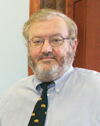
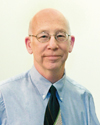
Ken Raymond Robert Bergman
Ken Raymond and Robert Bergman and their colleagues in the Chemical Sciences Division and UC Berkeley took cues from the way enzymes perform catalysis while immersed in aqueous solutions to devise water-soluble clusters of metals and organics that stabilize intermediate chemical compounds. In aqueous solution gallium ions, amines, and ketones spontaneously form tetrahedrons that can encapsulate imine molecules, important to many chemical and biological reactions, long enough for catalysis to occur. They described the technique in the Nov. 15 Journal of the American Chemical Society.
Unmasking the Lone Quark
Until recently, top quarks and antiquarks were found only in strong interactions, and only in pairs. On Dec. 8 the DZero experiment at Fermilab, a collaboration of more than 600 scientists from 90 institutions including Berkeley Lab, announced the discovery of single, unpaired top quarks produced in rare weak interactions. The experimenters used sophisticated analytic techniques to sift through the debris of a million billion particle collisions, finding a mere 60 events involving the lone quarks. “I am truly delighted by the DZero results,” said Pier Oddone, Fermilab’s director and formerly deputy director of Berkeley Lab.
Down in the Mines with Minuscule Microbes

Jillian Banfield pioneered shotgun-sequencing techniques for identifying microbes that live in biofilms in acidic mine wastewaters, methods recently used to discover three never-before-seen species.
An article in the Dec. 21 Science describes three new species of ancient Archaea found in slime growing in acid run-off from a California iron mine. Jillian Banfield of the Earth Sciences Division pioneered shotgun sequencing to sort out the identities of numerous microbes living in the biofilm, which resist culturing in the laboratory. Her UC Berkeley colleague Brett Baker used the technique to discover three new organisms no bigger than large viruses. Said Banfield, “This shows the great promise of shotgun sequencing to profile a community of organisms without making any assumptions about what is there.”
Gamma Rays in a Flash
Most astronomers thought that gamma-ray bursts, the brightest explosions in the universe, come in only two kinds: long bursts from collapsing massive stars, which form supernovae, and short bursts from merging neutron stars or black holes, which don’t. Joshua Bloom, UC Berkeley astronomer and guest in the Lab’s Physics Division, says it’s not so simple. In the Dec. 21 Nature, Bloom and his colleagues report two separate long bursts sans supernovae. “There are more ways than we thought for producing flashes of gamma rays,” Bloom said. “Instead of simplicity and clarity, we're seeing a rich diversity emerge.”
Exquisite Sequencing

Devices that can sequence nanoliter quantities of DNA have been pioneered in Richard Mathies's laboratory. This lab-on-a-chip was selected by Nature magazine as one of 2006's most striking scientific images.
Grad student Robert Blazej and colleagues in the laboratory of Richard Mathies, of UC Berkeley and the Lab’s Physical Biosciences Division, developed one of Mathies’s nanoliter-scale “labs on a chip” into a device so beautiful it earned a place in the Dec. 21 Nature magazine’s gallery of the most “bewitching” science images of 2006. A microfabricated bioprocessor that sequences tiny volumes of DNA, Nature says the circular glass device “could easily be from an album cover or the floor of a nightclub.”
The Charge of the Heavy Brigade

VENUS, built for the 88-Inch Cyclotron, has produced record quantities of massive, high-charge-state ions, approaching the performance needed for DOE's proposed Rare Isotope Accelerator, for which VENUS is the prototype ion source.
The Versatile ECR Ion Source for Nuclear Science, gracefully named VENUS, makes highly charged ions of species from hydrogen to uranium, using superconducting magnets to confine dense, hot, stable plasmas. Chosen as a prototype source for DOE’s high-priority Rare Isotope Accelerator (RIA), VENUS was developed by a team from AFRD, Engineering, and the ECR Ion Group at the Nuclear Science Division’s 88-Inch Cyclotron, led by Daniela Leitner. In late December Leitner announced that VENUS had produced the highest currents yet of high-charge-state uranium ions, exceeding RIA’s original specs on the way to meeting the latest demands for the spectacular new source.
From the Infinite to the Infinitesimal and Back
Dark matter is the “skeleton around which bright matter — galaxies and clusters of galaxies — assembles,” cosmologist Eric Linder wrote in Nature’s Jan. 7 online version. Physics Division researchers from disparate disciplines, the vanguard of a scientific trend, probe mysteries like dark energy, cosmological neutrinos, the cosmic microwave background, and the distribution of matter. “Dark energy and dark matter are natural targets for particle physicists,” says Natalie Roe, who is one, in the Jan. 5 Science. “Having realized that quarks and leptons are only five percent of the universe, I think it’s only natural to ask what the other 95 percent is.”
Crippling Deadly Cancers

Paraic Kenny
Many deadly tumors depend on a growth-factor receptor that signals cells when to divide; the receptor is activated by a series of other interactions. As reported online Jan. 11 in the Journal of Clinical Investigation, Mina Bissell and Paraic Kenny of the Life Sciences Division found that the enzyme TACE kick-starts the cascade. Blocking TACE blocks receptor activation and reverts breast cancer cells in 3-D culture to normal appearance. Drug companies are already testing drugs that inhibit TACE for treating rheumatoid arthiritis. Similar drugs could potentially treat cancers, including one of the deadliest forms of breast cancer.
Smoot's Excellent European Adventure
Nobel Féte in Stockholm
“Dr. Mather, Professor Smoot, cosmology has become a precision science and your ground-breaking research laid the foundation for that,” said Professor Per Carlson, Chairman of the Nobel Committee for Physics, in presenting the 2006 Nobel Prize in Physics to Berkeley Lab physicist George Smoot and John Mather of NASA Goddard Space Flight Center. Smoot and Mather received their prize in Stockholm on Dec. 10. They shared the award for their detailed observations of cosmic microwave background (CMB) radiation through the COBE (Cosmic Background Explorer) satellite, which “played a major role in the development of modern cosmology into a precise science.”
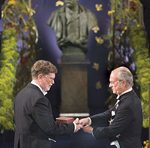
Smoot, left, with the King of Sweden
Smoot had delivered his Nobel lecture two days earlier (Dec. 8) at Aula Magna, Stockholm University, where he’d previously lectured after the COBE discovery announce-ment in 1992. He spoke in spite of having laryngitis and joked about being “pumped full of steroids” so he could talk. His treatment came through the help of Craig Mello who shared this year’s Nobel Prize in Medicine. As if the pressure of delivering a Nobel Prize lecture wasn’t enough, Smoot’s talk also doubled as the final lecture for the freshman physics course he teaches.
In his talk, which was entitled CMB, COBE and Cosmology, Smoot covered the history of CMB research starting with the Nobel Prize-winning discovery of the radiation in 1964 by Bell Labs scientists, Arno Penzias and Robert Wilson, proceeding to the COBE studies and then beyond to the results of WMAP, BOOMERANG and ACBAR. With each new study, the picture becomes increasingly precise of a CMB that is riddled with anisotropies—minute temperature fluctuations—that gave rise to the structures we observe in the universe today.
“We’re beginning to see the real harmonics of the universe,” Smoot said. “We now have a view of the universe where we have inflation at the beginning, the formation of structures and then the start of acceleration that cuts the process off.”
Following the awards ceremonies, there was a royal banquet and then a glittering ballroom dance for Smoot, the 11th Nobel Laureate to call Berkeley Lab his home. He is now back at the Lab, continuing his research and his teaching. He is still being inundated with requests for interviews and appearances.
— Lynn Yarris
Science and Surprise in Paris
In the fall of 2006 George Smoot was scheduled to visit Paris to teach at the International School of Astrophysics “Daniel Chalonge,” named for the pioneering French cosmologist. Smoot has supported the school, which offers programs in cosmology and astrophysics to graduate and postdoctoral students, since its founding in 1991.
But a conflict arose: the announcement of the 2006 Nobel Prize in Physics, which Smoot shares with John Mather. He was forced to cancel his teaching engagement.
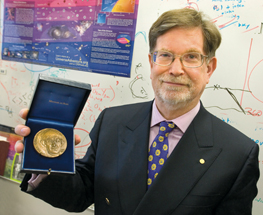
Smoot with Chalonge medal
To make up for it, says Smoot, “I promised to give a series of lectures and public appearances on my way back to California from Stockholm.” He arranged his early-December visit to Paris to coincide with meetings at French science agencies including the Centre Nationale d’Etudes Spatiale (CNES), the French version of NASA.
Smoot says, “The major emphasis was pushing forward a possible joint effort on SNAP,” the SuperNova/Acceleration Probe. He, Saul Perlmutter, and Michael Levi, SNAP’s co-principal investigators, discussed opportunities for further French collaboration at CNES, and Levi reports that the discussions went well; details are expected to emerge at the annual SNAP Collaboration meeting this week at Berkeley Lab.
Smoot’s other Paris appearances included the Palais de la Découverte science museum, the Madame Curie Museum, and the Collège de France. But his last stop was to the Chalonge School and an hours-long Nobel event held at the 17th-century Paris Observatory, for decades a contender with the Greenwich Observatory for the site of the world’s Prime Meridian.
The ceremony culminated with the surprise presentation of the Chalonge Medal to Smoot by the School’s director, physicist Norma Sánchez. It’s only the third time in the school’s 15-year history that the unique medal has been awarded.
— Paul Preuss
People, Awards, and Honors
Physicists Become APS Fellows




L-R: Walukiewicz, Attwood, Kolomensky, Matis
Five Berkeley Lab scientists have been elected American Physical Society Fellows. They include Wladyslaw Walukiewicz (Materials Sciences), who was recognized for his work in "amphoteric defects in semiconductors, Group-III nitrides, the effect of Mn interstitials in ferromagnetic semiconductors, and the formulation of the band structure of highly-mismatched semiconductor alloys"; David Attwood (Materials Sciences) for "the characterization and use of coherent extreme ultraviolet and soft x-ray radiation, and for pioneering work in laser interferometry of dense plasmas"; Yury Kolomensky (Physics) for "elucidating the spin structure of the nucleon, the electroweak theory and B-meson decays"; and Howard Matis (Nuclear Science) for "education and outreach on nuclear science including a website, wall-chart, guidebook, and Boy Scout merit badge, as well as a classroom cosmic-ray detector"; and Ian Hinchcliffe (Physics) for " theoretical and experimental physics of high energy colliders."
Computing Scientist Named APS Fellow

Lin-Wang
The American Physical Society (APS) has named Lin-Wang Wang a fellow in the Division of Computational Physics, an honor bestowed on scientists who have made outstanding contributions in the field. Wang, a member of the Lab's Scientific Computing Group, specializes in nanoscale electronic structure research. He was recognized for his “development of new computational algorithms in electronic structure calculations of large nanostructures.” The APS is the world’s largest professional group for physicists.
Alivisatos Shares Italian Prize for Solar Cell Work

Alivisatos
Paul Alivisatos, Associate Laboratory Director for physical sciences, has been named co-winner of the Eni Italgas Prize from Premio Italgas Energia & Ambiente, the Italian gas company. The prize, worth 120,000 Euros, honors relevant results in research on energy sources and their relation with the environment. Alivisatos and Nobelist Alan J. Heeger of UC Santa Barbara were chosen for their studies on next-generation solar cells. They will receive their awards in Torino in March.
Appointments, Fellowship For Computing Scientists
Three employees with the Lab's Computational Research Division (CRD) have recently been honored by scientific organizations. Vern Paxson, with the Distributed Systems Department, was named a fellow of the Association of Computing Machinery. Horst Simon, CRD director, was named to the DOE's Advanced Scientific Computing Advisory Committee. Juan Meza, head of CRD's High Performance Computing Research Department, will serve on the Society for Industrial and Applied Mathematics's committee on science policy, and was also elected to a three-year term on the American Association for the Advancement of Science's "Electorate Nominating Committee of the Section of Mathematics."
Safety Spot Awards Given to Employees


L-R: Buckley-Hernandez, Knight
Environment, Health & Safety Division Director Howard Hatayama recently presented Safety Spot awards to several employees. Fifty-eight awards have been given out since the program’s inception. This year's winners include Sharon Buckley Hernandez (AFRD), and Tracy Knight, (shown at left) Butch Holman, Robert Kelley, James Martinez, Melanie Woods, Gustavo Al Faro, Roger Deaver, Ryan Sprague, Dave Muster, Andy Cutt, Mark Seele and Joe Kappl, all from the Facilities Division.